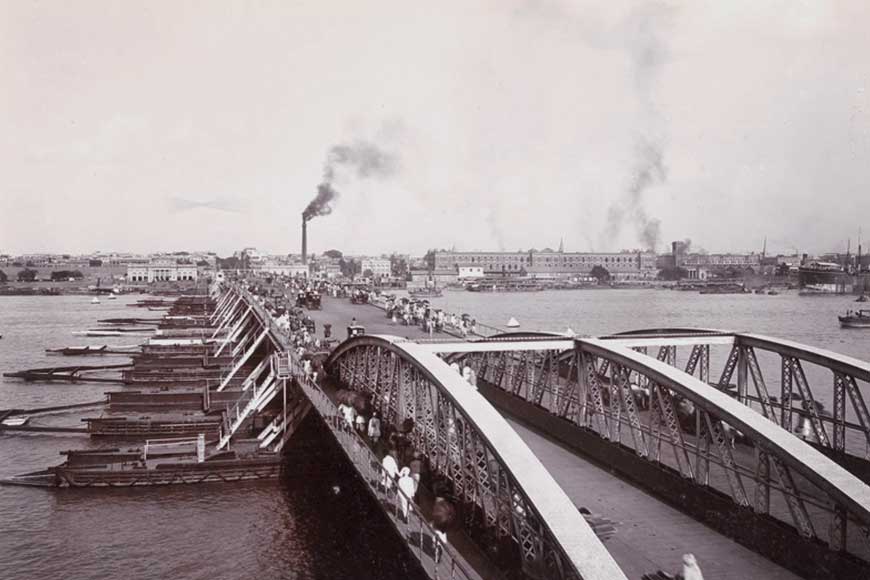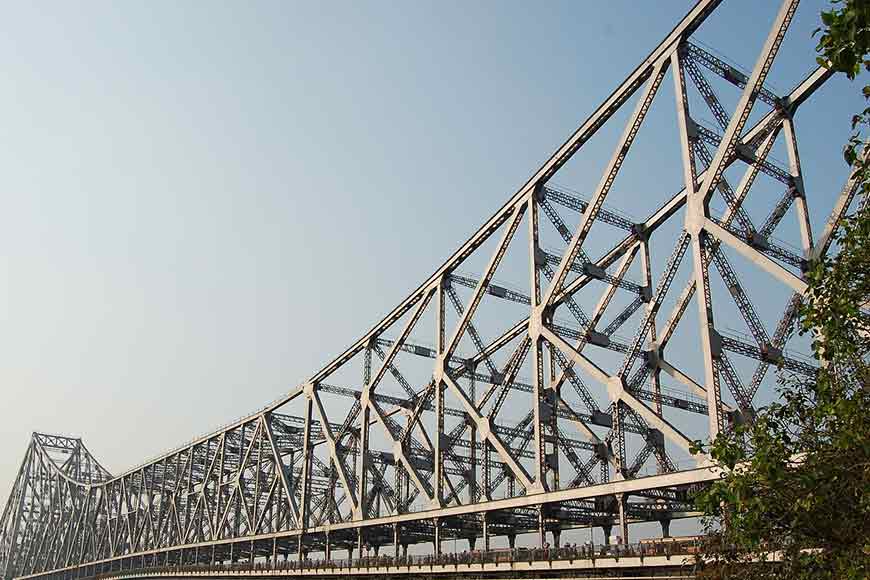Howrah Bridge, linking the past and present

The Howrah Bridge moves like a gigantic scorpion,
And Harrison Road follows it and proceeds along
Rabindranath Tagore had penned this limerick when the twin cities of Calcutta and Howrah were connected by a pontoon or floating bridge, a precursor of the present Howrah Bridge, now rechristened Rabindra Setu. The Howrah Bridge is one of the most recognized landmarks in Kolkata, connecting it with its neighbouring industrial city, Howrah over the Hooghly river.
The present bridge was officially opened to the public in 1943. Keeping in mind the memory of the previous pontoon bridge, the British named the new one as New Howrah Bridge. However, the masses preferred to call it simply the Howrah Bridge, and that stuck as its identity. Right from the beginning, the bridge inspired both awe and fascination. A Bollywood film named ‘Howrah Bridge’ was made. A foreign poet was inspired to write a book of poems with this bridge as his Muse. During World War II, there was trepidation about the Japanese Air Force airdropping bombs to destroy the bridge which was at that time in the last phase of construction. Everything is so unique about this bridge.
The hanging bridge across the Hooghly was also seen as an amazing engineering feat. Initially, the bridge was periodically unfastened to allow steamers and other marine vehicles to pass through. This bridge was not at the present site but was a little farther to the south. Fascinating stories galore about the ancient bridge. It was in 19th-century that Calcutta was getting a makeover and turning into an exquisite jewel in the Crown of the British Empire. East India Company’s business was expanding fast, and it was doing very well in Calcutta. This necessitated frequent movement between the two cities with goods and raw materials.
Availing the waterway was not only cumbersome but also time consuming. In view of the increasing traffic across the Hooghly river, a committee reviewed alternatives for constructing a bridge across it. On November 1838, a news was published in Bengal Herald. Newspaper. It said, the government had plans to construct a bridge on the Hooghly river and Rs 1,200,000 (a huge sum in those days) was sanctioned for the project. In 1852, Howrah Station was opened to the public. This further entailed the need for a bridge across the river. In 1862, the Government of Bengal asked George Turnbull, chief engineer of the East Indian Railway Company to study the feasibility of bridging the Hooghly River.

Turnbull had suggested a good place for the bridge was at Palta Ghat about a dozen miles north of Calcutta where a bed of stiff clay existed at no great depth under the river-bed, but this plan was cancelled. Meanwhile, the Calcutta Port Trust was founded in 1870. Finally, in 1871, construction of the bridge started. Different parts were constructed in England and shipped to Calcutta, where they were assembled.
The assembling period was fraught with problems. The bridge was considerably damaged by the great cyclone on 20 March 1874. A steamer named Egeria broke from her moorings and collided head-on with the bridge, sinking three pontoons and damaging nearly 200 feet of the bridge. The bridge was completed and opened to traffic on October 17, 1874. The Calcutta Port Trust was assigned for the maintenance of the bridge.
The pontoon bridge was a floating bridge. Initially the bridge was periodically unfastened to allow steamers and other marine vehicles to pass through. Pedestrians on both banks then would have to wait for clearance. The bridge was then 1528 ft. long and 62 ft. wide, with 7-foot wide pavements on either side. It had cost Rs 22 lakhs then to build the bridge. Calcuttans were mesmerized to see this new engineering marvel. But not all citizens were happy. Bharat Sanskarak magazine openly voiced its concern about the durability of the bridge. But the British government’s concern increased as the bridge could not handle the rapidly increasing load. Many passengers missed their trains as traffic movement would be stalled during unfastening of the bridge to let steamers and other marine vehicles to pass through. Initially it was decided that the bridge would be undone for the passage of vessels during daytime only and it would be opened at night for all vessels except ocean steamers, which were required to pass through during daytime. But even this measure proved temporary and the Port Commissioners started planning for a new improved bridge.
Also read : Light-and-sound show on Howrah Bridge!
The committee eventually decided on a floating bridge. It extended tenders to 23 firms for its design and construction. Prize money of 3,000 pounds (Rs 45,000, at the then exchange rate) was declared for the firm whose design would be accepted. The initial construction process of the bridge was stalled first due to the World War I and secondly due to the shifting of the national capital to Delhi. Finally, in 1922 a committee of engineers named the ‘Mukherjee Committee’ was formed, headed by R.N. Mukherji.
The committee proposed the formation of New Howrah Bridge Commission. On basis of the report, a global tender was floated. The lowest bid came from a German company, but due to increasing political tensions between Germany and Great Britain in 1935, it was not given the contract. Finally, Braithwaite, Burn & Jessop Construction Company was awarded the construction contract that year. The bridge was designed by Mr Walton who was an employee of the renowned British architect firm M/s Rendel, Palmer & Triton. Tata Steel supplied 26,500 tons of high-tension steel for construction of the bridge.
The construction of the bridge, both the original one and the new one was fraught with its fair share of accidents. One night, during the process of grabbing out the muck to enable the caisson to move, the ground below it yielded, and the entire mass plunged two feet, shaking the ground. The impact of this was so intense that the seismograph at Khidderpore, registered it as an earthquake and a Hindu Temple on the shore was destroyed, although it was subsequently rebuilt. While muck was being cleared, numerous varieties of objects were brought up, including anchors, grappling irons, cannons, cannonballs, brass vessels, and coins dating back to the Sultan, Mughal and East Indian Company era.
Again, World War II (1939–1945) intervened. Work continued amid all this but the government did not have a formal opening of the bridge due to fears of attacks by Japanese planes fighting the Allied Powers. No formal announcements were made either. On February 3, 1943, a tram car crossed the bridge from Calcutta and reached Howrah station and with that the bridge was formally opened to the public.
Since then, this 82-meter high, 71-foot bridge became the gateway to Calcutta and an inherent part of the city’s landscape. Although it is called Howrah Bridge, it is a signature architecture of Calcutta. The bridge has been the location of numerous movies. Old-timers will remember Ritwik Ghatak’s film, Bari Theke Paliye, where the city’s kaleidoscope view is introduced from the bridge. In 1958, the Hindi cult film Howrah Bridge was released. Roland Joff’s City of Joy poster depicts the bridge. The bridge is present prominently in recent Bollywood flicks like Barfi and Yuva. New Zealand’s famous poet James K. Baster wrote a book of poems titled, Howrah Bridge and Other Poems. There is no other bridge in the country that has inspired poets, authors, filmmakers, artists and other creative people as this bridge has. Its beauty and innovations are truly amazing.
The 77-year-old bridge is in technical term, ‘old’ now but it stands tall. Is the bridge ‘tired’ and needs rest? Engineers are raking their brains to find out. It still looks enticing as it sparkles in mauve lights that brighten up the structure at night. Commuters often stand still on their track and look at the giant structure. The river has lost much of its depth and flow. The twin cities on both sides of the river have expanded. More traffic snarls have become the order of the day. With more vehicles plying on the roads, the environment has become more polluted, it is hot and humid, there is more coercion, erosion… and the bridge stands testimony to the changing times, watching in silence from above. It stands bridging not just two cities but also the changing times.
The Howrah Bridge holds the intangible above/ And below flows time immemorial
(Punarbasan -- poem by Sankha Ghosh)










